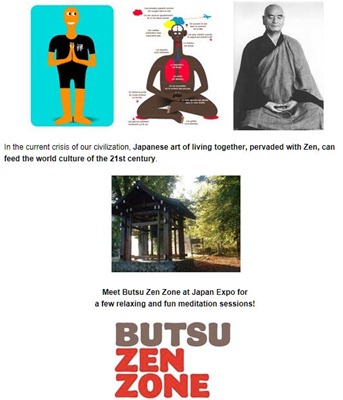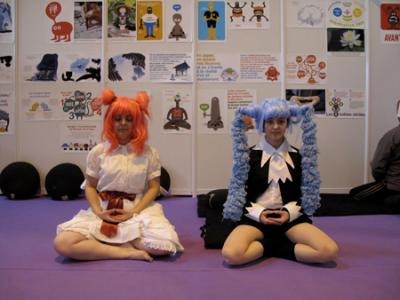« サッカーボール型のすごいヤツ | 最新記事 | 太陽光発電2011年前期の総括 »
2011年7月20日
日本が世界に誇る禅の文化

私たちがドイツで声明公演を行っていた時期を同じくして、フランス・パリではジャパンエキスポ2011が開催されていました。
 ジャパンエキスポは、毎年7月フランス・パリで行われる、日本のポップカルチャーと、書道や武道・茶道・折り紙などの伝統文化を紹介する日本文化のフェスティバルです。
今や日本文化といえば、マンガ・アニメ・ゲームを中心とし、音楽・モードを含めた日本のポップカルチャーがその代表格となっていますが、どうしてどうして、日本の長い伝統で培われてきた伝統文化も大きなブームとなっています。
ジャパンエキスポ会場ではマンガやアニメのコミックやDVD、関連グッヅ販売、ゲーム体験、サイン会、コンサート、ファッションショー等々・・・さまざまなプログラムが組まれ、毎年フランス国内はもとよりヨーロッパ諸国から17万を超える入場者を集めるヨーロッパ最大規模の日本フェスティバルです。
ジャパンエキスポ2011 概要
開催日‥ 2011年6月30日︵木︶~7月3日︵日︶11‥00~19‥00︵4日間︶
会場‥ フランス パリ・ノール ヴィルパント展示会会場 Parc d'Exposition Paris Nord Villepinte
入場料‥ 6/30︵木︶9ユーロ、7/1︵金︶12ユーロ、7/2︵土︶14ユーロ、7/3︵日︶12ユーロ。週末3日間パス31ユーロ。4日間パス35ユーロ。
入場者数‥ 前回2010年は17万4千人来場
日本の文化として﹁禅﹂も位置づけられており、禅のブース Butsu Zen Zone もありました。
ジャパンエキスポは、毎年7月フランス・パリで行われる、日本のポップカルチャーと、書道や武道・茶道・折り紙などの伝統文化を紹介する日本文化のフェスティバルです。
今や日本文化といえば、マンガ・アニメ・ゲームを中心とし、音楽・モードを含めた日本のポップカルチャーがその代表格となっていますが、どうしてどうして、日本の長い伝統で培われてきた伝統文化も大きなブームとなっています。
ジャパンエキスポ会場ではマンガやアニメのコミックやDVD、関連グッヅ販売、ゲーム体験、サイン会、コンサート、ファッションショー等々・・・さまざまなプログラムが組まれ、毎年フランス国内はもとよりヨーロッパ諸国から17万を超える入場者を集めるヨーロッパ最大規模の日本フェスティバルです。
ジャパンエキスポ2011 概要
開催日‥ 2011年6月30日︵木︶~7月3日︵日︶11‥00~19‥00︵4日間︶
会場‥ フランス パリ・ノール ヴィルパント展示会会場 Parc d'Exposition Paris Nord Villepinte
入場料‥ 6/30︵木︶9ユーロ、7/1︵金︶12ユーロ、7/2︵土︶14ユーロ、7/3︵日︶12ユーロ。週末3日間パス31ユーロ。4日間パス35ユーロ。
入場者数‥ 前回2010年は17万4千人来場
日本の文化として﹁禅﹂も位置づけられており、禅のブース Butsu Zen Zone もありました。

Try Zazen meditation! With Butsu Zen Zone, everything is in the mind, Zen, serene and a bit offbeat! Existing in Japan since the 13th century, this practice linking body and mind is entirely part of Japanese culture. Zen masters initiate you to sitted meditation, Zazen, at Japan Expo. On the hype, Kawaii and fun booth of Butsu Zen Zone, practice is illustrated by the new Zen aesthetic of the Western lands thanks to our artists who regularly publish in Japan. True Buddhas answer your deepest questions, even the most Banzai ones. What is Zen? Zen is mainly about practicing Zazen, a word coming from Za (to sit) and Zen (meditation). Zazen is nothing but sitting peacefully and being intimate with oneself. It does not rely on a dogma or ideology. It is a school of concentration, attention, self-knowledge and letting go. This practice has been transmitted from master to disciple, from people to people, for 2.500 years. The quiet position of Buddha is the perfect image of Zen. Sitting quietly, thinking about nothing in particular. Letting thoughts flow after becoming aware of a moment and coming back to being attentive to the position of the body and to breathing. This way, our mind, wholly aware of what surrounds it, remains available to every new moment. This is the essence of Zen: focusing on the posture and breathing. Zen in the Western world Master Taisen DESHIMARU taught and transmitted the practice of Zazen in Europe from 1967, when he arrived in France, to 1982 when he died. He is the heir of the purest tradition transmitted from the Indian Buddha Shakyamuni, Chinese Bodhidharma and Japanese Dogen. Disciple from Master Kodo SAWAKI, one of the greatest in Japan, he strongly desired to help contemporary men, whom he could feel were unbalanced, and make them understand their lives and themselves more deeply thanks to Zazen. His teaching was very concrete and deep inside everyday life. He often said: “Don’t separate the spiritual and the material. You must take up contradictions.” In the current crisis of our civilization, Japanese art of living together, pervaded with Zen, can feed the world culture of the 21st century. ︵Japan Expo 2011のサイトより引用︶ 会場の雰囲気もなかなか良いようで、
We were able to staff the stands at Paris and Montreuil mainly with members of Neuilly and Tolbiac dojos, and then had the help of the major southern dojos near Marseille (where we did over 250 introductions, with fans sometimes queuing for a zafu!), so the participation of different sanghas was invaluable. It is a unique experience to present the practice I shin den shin to strangers, even for a near beginner! Even if seated zazen is demanding, what we presented is a strong but joyful practice, and we do not see any reason to leave the monopoly in Buddhist smiles and laughter to the Dalai Lama. The public must have been aware of this atmosphere at the Butsu Zen Zone, sensing the open-mindedness, joy and considerable humour. In short, it was a lot of fun! In any case, it seems that the motionless beauty of the zazen posture in the middle of this friendly chaos has struck people’s minds because, after participating three times, we are now among the ‘events not to be missed at Japan Expo’ and the organisers insist on our continued presence. という記述もありました。
フランスを拠点とするAZI(Association Zen Internationale)のサイトに JapanExpoの参加レポートが掲載されていました。
Zazen à la JAPAN EXPO ︵写真はAZIのサイトより︶
︵写真はAZIのサイトより︶
折角のJapanExpoですので、日本から禅僧が積極的に参加して、ブース出展することを検討してもよいのではないでしょうか。 ﹁本物﹂が与えるインパクトも大きいと思います。 日本が世界に誇る文化たる禅へ理解をより深めるために。
■関連ブログ記事
FOODEX JAPAN特設ステージ
 ジャパンエキスポは、毎年7月フランス・パリで行われる、日本のポップカルチャーと、書道や武道・茶道・折り紙などの伝統文化を紹介する日本文化のフェスティバルです。
今や日本文化といえば、マンガ・アニメ・ゲームを中心とし、音楽・モードを含めた日本のポップカルチャーがその代表格となっていますが、どうしてどうして、日本の長い伝統で培われてきた伝統文化も大きなブームとなっています。
ジャパンエキスポ会場ではマンガやアニメのコミックやDVD、関連グッヅ販売、ゲーム体験、サイン会、コンサート、ファッションショー等々・・・さまざまなプログラムが組まれ、毎年フランス国内はもとよりヨーロッパ諸国から17万を超える入場者を集めるヨーロッパ最大規模の日本フェスティバルです。
ジャパンエキスポ2011 概要
開催日‥ 2011年6月30日︵木︶~7月3日︵日︶11‥00~19‥00︵4日間︶
会場‥ フランス パリ・ノール ヴィルパント展示会会場 Parc d'Exposition Paris Nord Villepinte
入場料‥ 6/30︵木︶9ユーロ、7/1︵金︶12ユーロ、7/2︵土︶14ユーロ、7/3︵日︶12ユーロ。週末3日間パス31ユーロ。4日間パス35ユーロ。
入場者数‥ 前回2010年は17万4千人来場
日本の文化として﹁禅﹂も位置づけられており、禅のブース Butsu Zen Zone もありました。
ジャパンエキスポは、毎年7月フランス・パリで行われる、日本のポップカルチャーと、書道や武道・茶道・折り紙などの伝統文化を紹介する日本文化のフェスティバルです。
今や日本文化といえば、マンガ・アニメ・ゲームを中心とし、音楽・モードを含めた日本のポップカルチャーがその代表格となっていますが、どうしてどうして、日本の長い伝統で培われてきた伝統文化も大きなブームとなっています。
ジャパンエキスポ会場ではマンガやアニメのコミックやDVD、関連グッヅ販売、ゲーム体験、サイン会、コンサート、ファッションショー等々・・・さまざまなプログラムが組まれ、毎年フランス国内はもとよりヨーロッパ諸国から17万を超える入場者を集めるヨーロッパ最大規模の日本フェスティバルです。
ジャパンエキスポ2011 概要
開催日‥ 2011年6月30日︵木︶~7月3日︵日︶11‥00~19‥00︵4日間︶
会場‥ フランス パリ・ノール ヴィルパント展示会会場 Parc d'Exposition Paris Nord Villepinte
入場料‥ 6/30︵木︶9ユーロ、7/1︵金︶12ユーロ、7/2︵土︶14ユーロ、7/3︵日︶12ユーロ。週末3日間パス31ユーロ。4日間パス35ユーロ。
入場者数‥ 前回2010年は17万4千人来場
日本の文化として﹁禅﹂も位置づけられており、禅のブース Butsu Zen Zone もありました。

Try Zazen meditation! With Butsu Zen Zone, everything is in the mind, Zen, serene and a bit offbeat! Existing in Japan since the 13th century, this practice linking body and mind is entirely part of Japanese culture. Zen masters initiate you to sitted meditation, Zazen, at Japan Expo. On the hype, Kawaii and fun booth of Butsu Zen Zone, practice is illustrated by the new Zen aesthetic of the Western lands thanks to our artists who regularly publish in Japan. True Buddhas answer your deepest questions, even the most Banzai ones. What is Zen? Zen is mainly about practicing Zazen, a word coming from Za (to sit) and Zen (meditation). Zazen is nothing but sitting peacefully and being intimate with oneself. It does not rely on a dogma or ideology. It is a school of concentration, attention, self-knowledge and letting go. This practice has been transmitted from master to disciple, from people to people, for 2.500 years. The quiet position of Buddha is the perfect image of Zen. Sitting quietly, thinking about nothing in particular. Letting thoughts flow after becoming aware of a moment and coming back to being attentive to the position of the body and to breathing. This way, our mind, wholly aware of what surrounds it, remains available to every new moment. This is the essence of Zen: focusing on the posture and breathing. Zen in the Western world Master Taisen DESHIMARU taught and transmitted the practice of Zazen in Europe from 1967, when he arrived in France, to 1982 when he died. He is the heir of the purest tradition transmitted from the Indian Buddha Shakyamuni, Chinese Bodhidharma and Japanese Dogen. Disciple from Master Kodo SAWAKI, one of the greatest in Japan, he strongly desired to help contemporary men, whom he could feel were unbalanced, and make them understand their lives and themselves more deeply thanks to Zazen. His teaching was very concrete and deep inside everyday life. He often said: “Don’t separate the spiritual and the material. You must take up contradictions.” In the current crisis of our civilization, Japanese art of living together, pervaded with Zen, can feed the world culture of the 21st century. ︵Japan Expo 2011のサイトより引用︶ 会場の雰囲気もなかなか良いようで、
We were able to staff the stands at Paris and Montreuil mainly with members of Neuilly and Tolbiac dojos, and then had the help of the major southern dojos near Marseille (where we did over 250 introductions, with fans sometimes queuing for a zafu!), so the participation of different sanghas was invaluable. It is a unique experience to present the practice I shin den shin to strangers, even for a near beginner! Even if seated zazen is demanding, what we presented is a strong but joyful practice, and we do not see any reason to leave the monopoly in Buddhist smiles and laughter to the Dalai Lama. The public must have been aware of this atmosphere at the Butsu Zen Zone, sensing the open-mindedness, joy and considerable humour. In short, it was a lot of fun! In any case, it seems that the motionless beauty of the zazen posture in the middle of this friendly chaos has struck people’s minds because, after participating three times, we are now among the ‘events not to be missed at Japan Expo’ and the organisers insist on our continued presence. という記述もありました。
フランスを拠点とするAZI(Association Zen Internationale)のサイトに JapanExpoの参加レポートが掲載されていました。
Zazen à la JAPAN EXPO
 ︵写真はAZIのサイトより︶
︵写真はAZIのサイトより︶
折角のJapanExpoですので、日本から禅僧が積極的に参加して、ブース出展することを検討してもよいのではないでしょうか。 ﹁本物﹂が与えるインパクトも大きいと思います。 日本が世界に誇る文化たる禅へ理解をより深めるために。
投稿者: kameno 日時: 2011年7月20日 11:27

